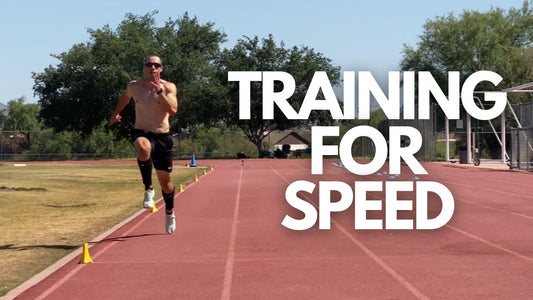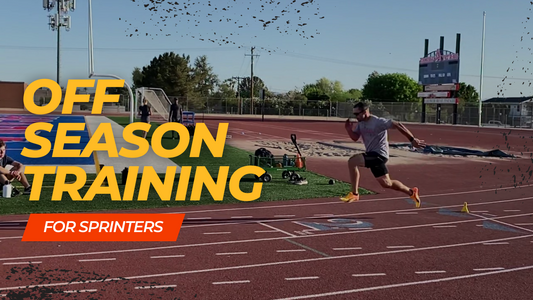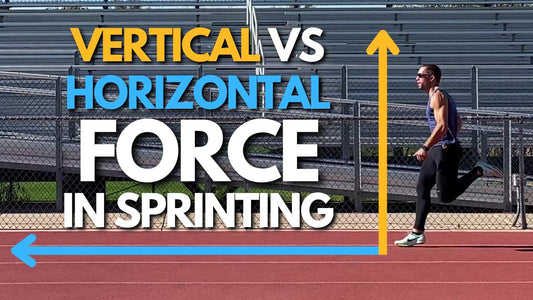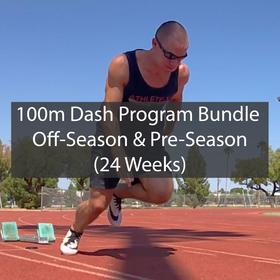Sprinting Benefits - The Health & Performance Benefits Of Sprinting
The Health & Performance Benefits Of Sprinting
Sprinting has many benefits for your health, body composition, and athletic performance.
Here you will learn the benefits of sprinting and how you can add sprint workouts to your running training.
What's In This Article:
Sprinting Benefits
What are the benefits of incorporating sprinting into my workout routine?
By adding a sprinting routine to your training program, you will experience benefits such as:
- Increased muscle power
- Stronger upper body and leg muscles
- Enhanced fat burning
- Reduced risk of high blood pressure
- Reduced blood cholesterol levels
- Improved blood circulation
- Increased bone density and improved bone health
- Better glucose control and blood sugar levels
- Enhanced protein synthesis, promoting muscle growth
- Improved insulin sensitivity and reduced insulin resistance
- Lower risk of heart disease
- Increased fast twitch muscle fibers
Sprinting is one of the best forms of intense exercise. Whether you are interested in sprinting for fat loss, improving at the 100-meter dash, or how sprinting can make you run faster, you can rest assured a sprinting workout is a great exercise choice.
Benefits of Sprinting Vs. Jogging
While jogging is a popular and effective form of training, there are benefits to sprinting that cannot be achieved through jogging alone. Long distance runners should incorporate anaerobic training like a sprinting workout.
Because sprinting is such a high-intensity activity, sprinting will recruit fast twitch muscle fibers, which can help you run faster. Jogging will instead develop slow twitch muscle fibers.
Jogging will help develop your aerobic energy system and improve your heart health, but sprinting will do more to build muscle, tendons, and nervous system.
When we sprint, the brain must coordinate movements at very rapid speeds, which can help increase the amount of force, power, and running speed you can achieve.

Sprinting will help improve joint stiffness and tendon elasticity, which can help improve your running economy.
By having better running economy, you'll be able to run faster and farther without getting as tired. The more elastic your tendons and the more joint stiffness you have when running, the less energy the muscles require to fuel your movement.
Sprinting is also a more time-efficient way to train. When jogging at a slower pace, you may need to continuously run for an hour or more to gain any benefits.
With sprinting, you can perform a workout in 20 to 30 minutes that will burn more fat and cause more robust adaptations than jogging alone. Adding sprinting to your current training program will supercharge your results!
The main benefits of sprinting vs. jogging include the following:
- Sprinting will make the average runner faster than jogging will.
- Sprinting will make you stronger and more explosive than jogging.
- Sprinting will train your nervous system for better coordination.
- Sprinting will improve your running economy more than jogging.
- Sprinting offers benefits in a short period of time.
Health Benefits of Sprinting
Sprinting has many health benefits which can help you be as healthy as possible. Some of these benefits include:
- Lowering your high blood pressure
- Reducing your cholesterol levels
- Improving your blood circulation
- Increasing bone density
- Enhanced glucose control
- Lower blood sugar levels
- Improved insulin sensitivity and insulin resistance
- Lower risk of heart disease
- Improved hormone levels such as testosterone and HGH
Sprinting in an all out effort is a powerful method for burning belly fat, typically associated with health problems like metabolic diseases, including obesity and diabetes. Research shows that a sprinting workout can burn more fat in less time than slower forms of running.
Sprinting has been shown to lower your blood pressure after sprint interval training. Sprinting can also reduce blood pressure in youth. If more people sprinted regularly, we could improve the health of our society!
Sprinting can also reduce insulin sensitivity and cholesterol levels, especially LDL or "bad" cholesterol. Sprinting may be an excellent way to prevent diseases such as heart disease without running for hours on end every day.
Sprinting increases testosterone and growth hormone levels, promoting vitality and improved recovery from training.
Benefits Of Sprinting Uphill
Sprinting can be performed on flat ground or in the form of hill sprints at a maximum effort. Hill sprints are typically a safer way to sprint and come with many benefits.
Sprinting uphill has been shown to improve 3km time trials, agility, strength, and V02 max. Another study shows that uphill sprinting can benefit your time to exhaustion, meaning you can run farther before needing to stop.
When we perform uphill sprinting, we have to work against gravity to launch ourselves up the hill as fast as possible. This also helps you learn proper form for acceleration, increases your stride length, and can build muscle mass in your legs.
This means that uphill sprinting can have benefits such as improved explosive power, faster acceleration, increased strength, and the ability to run faster.
Benefits Of Sprinting For Fat Loss
Sprinting should be at the top of your list if you want the best exercise for fat loss.
Research has repeatedly shown that sprinting and sprint interval training is a time-efficient ways to burn fat, especially visceral fat, which is particularly unhealthy.
Once you are warmed up, sprint workouts can be completed in as little as 10 or 20 minutes. Because sprinting is a high intensity activity, you can benefit from sprinting quickly, which would take much longer if you run slowly.
How To Benefit From Sprinting
Sprint At Least Once Per Week
You can benefit from sprinting in as little as one training session per week. This is particularly useful if you perform other types of training, such as jogging, strength training, or swimming.
Sprinting can complement the rest of your training program by giving you an option for high-intensity anaerobic exercise that will recruit fast twitch fibers and burn fat like an incinerator.
You can do short-distance acceleration training or take a more moderate approach with tempo runs or build-up strides. Whatever you do, take your time easing into the sprinting routine over a few weeks.
Your first sessions can be submaximal such as sprinting at 85% or working up to 90% or faster throughout a few workouts. Focus on proper sprinting form so you can run fast and stay injury-free.
Frequently Asked Questions About Sprinting Benefits
What are the benefits of sprinting for weight loss?
Sprint workouts are highly effective at causing weight loss. Specifically, running fast in short bursts allows you to get more calorie burn for every minute of exercise compared to slower forms of running.
Adding one or two sprint workouts to your weekly exercise routine will boost your body’s ability to lose weight and maintain healthy body composition.
How does sprinting improve cardiovascular health?
Running sprints helps promote heart health through various processes.
First, sprinting elevates your heart rate, which helps strengthen your heart muscles and improve of the vascular system.
For example, one study found that peripheral stiffness in the vascular system was improved following very high-intensity sprints. This reduction in stiffness can help lower blood pressure and promote health.
Similarly, another study concluded that sprint interval training is a more time-efficient way to improve vascular function than endurance training.
For better heart function, practice some heart healthy sprinting so you can have impeccable cardiovascular fitness.
Can sprinting help improve my athletic performance?
In my experience as a track & field and NFL combine preparation coach, sprinting is the best anaerobic exercise for increasing athletic performance.
Elite athletes who train to sprint faster have better performance on the field, can sprint at faster speeds, have better agility, and are less injury prone than athletes who do not sprint. Also, practicing the skill of sprinting helps ensure you develop proper sprinting form.
Sprinting helps not only your running speed but also your reaction time and speed of movement overall. By learning to move your body as fast as possible while running, you’ll be better able to kick or throw a ball, swing a bat or golf club, or weave in and out of defenders in football and soccer games.
Also, because of the effects on running economy, long distance runners can benefit greatly from sprinting.
Sprinting should be a part of every athletic performance training program, as the benefits of sprinting are unmatched by any other form of training.
How does sprinting help build muscle and improve body composition?
To build muscle and incinerate fat, you need to activate large amounts of muscle tissue. The more you can do this and do it at a high-intensity level, the more effective your workouts will be at building muscle and improving body composition.

Because sprinting activates so many muscles in the body very quickly, it will elicit a potent release of testosterone and growth hormone, both of which will promote increased muscle mass, lean body mass, and reduced body fat levels. There is a reason why sprinters are muscular!
Additionally, calorie burn from sprinting doesn’t stop after the workout. Once you have completed an intense workout of sprint exercises, your body will continue to utilize energy at a higher rate, allowing you to keep burning calories even after the workout is done.
Are there any mental health benefits to sprinting?
Sprinting has been great for my mental health.
High intensity training has been shown in research to reduce symptoms of depression and perceived stress while also improving people’s overall mental well-being.
When you knock out an intense sprint session, your body releases endorphins that make you feel good. Plus, the sense of accomplishment and the feeling of being athletic can do wonders for one’s self-esteem and confidence.
Can sprinting help improve my overall speed and agility?
Sprinting is by far the best method for increasing your running speed and agility.
First, the most effective way to get faster is to practice it through doing speed work. Performing short sprints with adequate recovery time is a time-tested method for making athletes faster.
Second, agility is a skill of speed, strength, and reactive ability. By practicing speed work regularly, you will find that your agility improves much more than by doing agility ladders or other popular training fads.
What are the cardiovascular benefits of interval sprinting compared to traditional steady-state cardio?
Interval sprinting can be more effective than traditional steady-state cardio for weight loss and improving cardiovascular health.
Interval sprinting involves short bursts of high-intensity activity followed by periods of rest or lower-intensity activity.
This type of anaerobic exercise can increase calorie burn and improve cardiovascular fitness more effectively than steady-state cardio.
Is sprinting a good way to improve my endurance?
Sprinting is a great way to improve your endurance, especially when added to an exercise program that already includes moderate-intensity continuous training.
Sprints will improve your running economy, a proxy for how much oxygen your body consumes at a given level of effort. By boosting your running economy with sprint training, you can run farther and longer without getting tired.
Sprinting also increases your speed reserve. By increasing your top speed through the effects of sprinting workouts, you can run faster at submaximal intensities.
A person who can run 10 meters per second will run faster at 80% speed than someone who can only reach 9 meters per second at maximal velocity.
Speed reserve is a vital endurance characteristic, especially for athletes in the long sprints, middle-distance events, endurance athletes, or sports like soccer, football, and basketball.
How does sprinting impact my metabolism and calorie burn throughout the day?
Sprint workouts can improve your metabolism, cause you to burn more calories throughout the day, and make you a healthier person.
Research has shown that sprint intervals activate large amounts of muscle tissue, causing your body to burn calories while improving microvascular function.
Individuals with metabolic diseases such as Type-2 Diabetes can see improved metabolic function due to including sprint interval workouts into the exercise program.
These sprints can be done by running on a stationary bike, a normal bicycle, or a sprinting treadmill.
How long should you do sprints for?
How much you sprint will depend on your goals, but there are some best practices to follow.
These include:
- Only sprint as far as you can while maintaining good sprinting technique.
- You should stop doing sprints once you start to slow down significantly, as sprinting needs to be done at high speeds with high movement quality.
- Sprint up to 3 times weekly, so you have enough time to recover between sprinting sessions. This helps improve the effects of your workouts while also minimizing injury risk.
When sprinting, make sure to listen to your body. You want to challenge yourself but should not look at sprinting as something where more is always better. You can get a major benefit from sprinting without doing massive work.
What Happens If I Sprint Every Day?
I advise against sprinting every day because most people need to recover quickly enough between sessions. You may be able to sprint every day for a week or two, but eventually, you will burn out, get injured, or become overtrained.
Instead, focus on sprinting two or three times per week, focusing on consistency over time. You will see better results over long periods by approaching your sprinting routine in this manner.
Also, incorporate strength training into your routine to help promote muscle growth in the leg muscles used in sprinting. If you sprint a few times per week and add in some strength training workouts, you will see better results than sprinting every day.
Do Sprints Raise Testosterone?
Sprints can be a great way to boost testosterone levels.
Research has shown that interval training can increase salivary testosterone levels in athletes, and anecdotal evidence suggests that proper volumes of sprint training can help optimize testosterone levels.
Combined sprint and strength training has also been found in scientific research to increase testosterone levels in middle-aged men, suggesting that sprinting helps promote healthy testosterone levels and limit the usual decline in testosterone that comes with age or as is seen in endurance athletes.
This increase in testosterone will promote muscle growth and reduced body fat.
Does Sprinting Boost HGH?
Sprinting boosts HGH. According to one study, sprint-trained athletes showed a significant increase in growth hormone levels in the hour following a bout of sprint training.
This increased human growth hormone release following sprinting makes sprinting a great tool for muscle building and maintaining good body composition. HGH helps promote protein synthesis and prevent protein degradation, aiding in muscle growth and fat burning.
If you want to increase your human growth hormone levels naturally, adding sprints to your exercise routine is a safe, healthy, and effective way to do so.
Does Sprinting Increase Lifespan?
Sprinting has been researched for its effects on longevity. In my article on the anti-aging effects of sprinting, research is covered, which suggests that sprinting increased telomere length in masters sprinters.
Telomere length is closely tied with increasing lifespan, improving longevity, anti-aging, and having a higher quality of life as we age.
If you want to live a longer life and stay healthy into old age, consistently sprinting as a part of your intense exercise program is a great route to take.
Do Sprints Make Calves Bigger?
Sprints make your calves bigger. Because the calves are used to propel the body off the ground in each step of a sprint, you can see major changes in calf strength and muscle growth as a result of sprinting.
Over time, I have seen my calves grow more prominent, become more toned, and sit high up on my lower leg compared to when I first started sprinting.
Building calves through the muscle growth caused by sprinting will improve your top speed, reduce your ground contact times, and help you achieve proper form.
How Should Beginners Get Started With Sprinting?
For more information on how to get started sprinting, check out my post on sprinting for beginners, learn about sprinting workouts, or pick up a sprint training program.
References:
- Burns SF, Oo HH, Tran AT. Effect of sprint interval exercise on postexercise metabolism and blood pressure in adolescents. Int J Sport Nutr Exerc Metab. 2012 Feb;22(1):47-54. doi: 10.1123/ijsnem.22.1.47. PMID: 22248500.
- Chan HH, Burns SF. Oxygen consumption, substrate oxidation, and blood pressure following sprint interval exercise. Appl Physiol Nutr Metab. 2013 Feb;38(2):182-7. doi: 10.1139/apnm-2012-0136. Epub 2013 Feb 8. PMID: 23438230.
- Kavaliauskas M, Kilvington R, Babraj J. Effects of in-season uphill sprinting on physical characteristics in semi-professional soccer players. J Sports Med Phys Fitness. 2017 Mar;57(3):165-170. doi: 10.23736/S0022-4707.16.06066-7. Epub 2015 Dec 3. PMID: 26658434.
- Kavaliauskas M, Jakeman J, Babraj J. Early Adaptations to a Two-Week Uphill Run Sprint Interval Training and Cycle Sprint Interval Training. Sports (Basel). 2018 Jul 27;6(3):72. doi: 10.3390/sports6030072. PMID: 30060478; PMCID: PMC6162401.
- Sandvei M, Jeppesen PB, Støen L, Litleskare S, Johansen E, Stensrud T, Enoksen E, Hautala A, Martinmäki K, Kinnunen H, Tulppo M, Jensen J. Sprint interval running increases insulin sensitivity in young healthy subjects. Arch Physiol Biochem. 2012 Jul;118(3):139-47. doi: 10.3109/13813455.2012.677454. Epub 2012 Apr 28. PMID: 22540332.
- Olver, T. D., & Laughlin, M. H. (2016). Endurance, interval sprint, and resistance exercise training: impact on microvascular dysfunction in type 2 diabetes. American journal of physiology. Heart and circulatory physiology, 310(3), H337–H350. https://doi.org/10.1152/ajpheart.00440.2015
- Rakobowchuk, M., Stuckey, M. I., Millar, P. J., Gurr, L., & Macdonald, M. J. (2009). Effect of acute sprint interval exercise on central and peripheral artery distensibility in young healthy males. European journal of applied physiology, 105(5), 787–795. https://doi.org/10.1007/s00421-008-0964-7
- Martland R, Korman N, Firth J, et alCan high-intensity interval training improve mental health outcomes in the general population and those with physical illnesses? A systematic review and meta-analysisBritish Journal of Sports Medicine 2022;56:279-291.
- Zouhal H, Jayavel A, Parasuraman K, Hayes LD, Tourny C, Rhibi F, Laher I, Abderrahman AB, Hackney AC. Effects of Exercise Training on Anabolic and Catabolic Hormones with Advanced Age: A Systematic Review. Sports Med. 2022 Jun;52(6):1353-1368. doi: 10.1007/s40279-021-01612-9. Epub 2021 Dec 22. PMID: 34936049; PMCID: PMC9124654.
- Sellami, M., Dhahbi, W., Hayes, L. D., Kuvacic, G., Milic, M., & Padulo, J. (2018). The effect of acute and chronic exercise on steroid hormone fluctuations in young and middle-aged men. Steroids, 132, 18–24. https://doi.org/10.1016/j.steroids.2018.01.011
- Váczi, M., Nagy, S. A., Kőszegi, T., Ambrus, M., Bogner, P., Perlaki, G., Orsi, G., Tóth, K., & Hortobágyi, T. (2014). Mechanical, hormonal, and hypertrophic adaptations to 10 weeks of eccentric and stretch-shortening cycle exercise training in old males. Experimental gerontology, 58, 69–77. https://doi.org/10.1016/j.exger.2014.07.013

Online Training Group
Get workouts sent to your phone to help you get stronger, sprint faster, and jump explosively.
Sprint Training Articles
View all-

Training For Speed - Methods, Progressions & Ti...
Speed training is fundamentally the primary way to train in order to sprint faster. Social media influencers and coaches throw the term speed training around loosely, when in reality it...
Training For Speed - Methods, Progressions & Ti...
Speed training is fundamentally the primary way to train in order to sprint faster. Social media influencers and coaches throw the term speed training around loosely, when in reality it...
-

How Should Sprinters Train In Their Off Season?
After a long season of training and competition, many sprinters find themselves wondering what they should do once the season has come to a close. Some continue to train hard,...
How Should Sprinters Train In Their Off Season?
After a long season of training and competition, many sprinters find themselves wondering what they should do once the season has come to a close. Some continue to train hard,...
-

Force Production In Sprinting | Is Vertical Or ...
In discussions surrounding sprint performance, coaches and researchers have debated whether vertical force or horizontal force is more important for running fast. While many will pick a side and claim...
Force Production In Sprinting | Is Vertical Or ...
In discussions surrounding sprint performance, coaches and researchers have debated whether vertical force or horizontal force is more important for running fast. While many will pick a side and claim...
Sprint Training Programs
-
100 Meter Dash Training Program Off-Season & Pre-Season Bundle
Regular price $47.00 USDRegular priceUnit price / per$99.00 USDSale price $47.00 USDSale -
400m Dash Off-Season & Pre-Season Training Program Bundle
Regular price $47.00 USDRegular priceUnit price / per$95.97 USDSale price $47.00 USDSale -
200m Dash Off-Season & Pre-Season Training Program Bundle
Regular price $47.00 USDRegular priceUnit price / per$95.97 USDSale price $47.00 USDSale -
Indoor Off Season Bundle - 60 Meter & 200 Meter Dash GPP Training Programs
Regular price $62.00 USDRegular priceUnit price / per$78.00 USDSale price $62.00 USDSale







